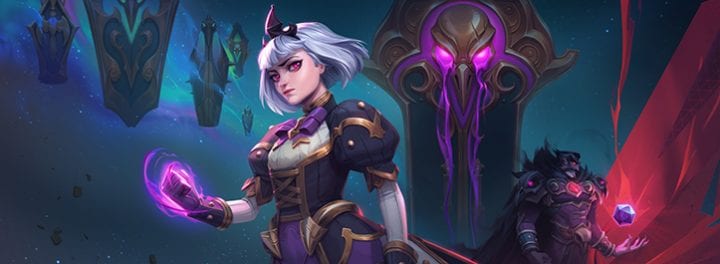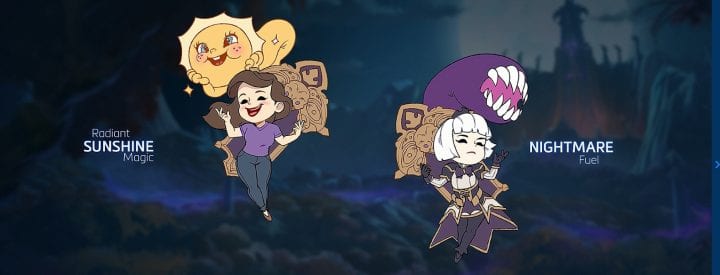
Diving Deep into Orphea
by JR Cook - 6 years ago show comments
Several members of the Heroes team took the stage at Blizzcon today to take a deep dive into all things Orphea. They discussed the inspiration for her creation, how her character was developed, how that inspired things like her art and animation, and some of the ideas behind her talents and abilities.
Orphea’s Story
First up was Kevin “Cloaken” Johnson, Creative Content Lead, to provide a little background on how Orphea came to be.

Since work first began on Heroes of the Storm the team has always wanted to bring a Nexus inspired Hero into the game. The release earlier this year of Alterac Pass marked a major milestone in that they finally had all of the core Blizzard IPs incorporated into the game. With that accomplished, they felt like the time was right to shore up the identity of Heroes as a stand-alone game by releasing a Hero from that universe.
They feel like Orphea goes back to the roots of the game but is still entirely new at the same time. Heroes has always been a game with a mix of non-traditional fantasy ideas and Blizzard fantasy. The first eight battlegrounds were all brand new ideas that introduced a lot of cool new characters like the Spider Queen, Blackheart, and of course the Raven Lord.

The decision to finally introduce a Nexus inspired Hero started to take hold about a year ago. The idea of the Raven Lord’s daughter was something that immediately appealed to them so the passed the idea to the art team and they came up with some concept art.
That art helped fuel the creation of her character and fantasy. Questions like “What is up with that big box on her back and the monster?” and “Where does it come from?” had to be answered. The team set about creating a narrative in the form of comics that would set up the rules of the Nexus as a place and why Orphea exists. All of this took place before they had any idea what her abilities would be.
The process to create Orphea as a character was extremely collaborative. Different teams like Art, Design, and Animation all worked together to come up with ideas that would shape the design and fantasy of Orphea.

Next Kevin talked a bit about what the Nexus is. He said the Nexus is a universe of universes. The energy of the storm is split up into realms, which are controlled by Realm Lords. These Realm Lords are basically the demigods of the Nexus.
Orphea is the daughter of a Realm Lord. Raven Court, her father’s realm, is one of the oldest realms in the Nexus. Orphea had a lonely upbringing but a strong connection to her ancestors. She has lived her whole life in the Nexus and her journey to become a hero was an introspective one. She watched as her father became obsessed with gather knowledge. Her mother left because of concerns over the dark turn Orphea’s father was taking in his pursuit of the Dark Nexus. Orphea had a strong bond so she decided to stay with her father despite her mother’s concerns.
Orphea made her father promise to never tap into the Dark Nexus but as Heroes players know, he did not keep that promise. This caused Orphea to run away, taking a powerful family relic with her. Orphea returned to confront her father after his campaign to take over the Dark Nexus, establishing herself as a Hero of the Nexus.
The next comic will shed even more light on her backstory…
Creating Orphea’s Animations
Next up was Lana Bachynski, Senior Animator, to talk about how all of this backstory relates to her in-game art design.
When they first saw the concept art for Orphea they didn’t even know her name, let alone her abilities. Most Blizzard characters arrive with a strong sense of identity but Orphea was something entirely new, something entirely theirs. The challenge was to make her familiar, unique, and awesome.
Starting from nothing isn’t always liberating. They had to find structure, add rules, and ask questions in order to build her fantasy. The coffin relic reflects her personality and her feelings. If someone else were to wield it the results might be different but because of Orphea’s angst and anger, the relic becomes nightmare fuel.

When the team was working on Orphea one ability really stood out to them: Chomp. The inspiration was that if you are going to have a giant monster it should take a bite out of something! They fleshed out the model for Chomp, which they refer to as dentures.
The idea worked well in a vacuum but in playtesting it felt detached. With so much focus on the monster, they felt like Orphea’s purpose was just that of a relic holder and they wanted more. They started trying to work Orphea’s personality more into the graphics of her abilities. One way this was done was by adding additional color to the effects.

An early concept for Orphea described her as a dancer and they wanted to hold onto that visual. They wanted her to be light on her feet, able to engage with the enemy and then dance away. They wanted her to appear poised and as if carrying the massive relic was nothing to her. The goal was to bring out her character through gameplay.
Designing Orphea
Senior Hero Designer Kyle Dates took center stage next to talk more about Orphea’s design.
He said fantasy is what makes you feel like you are playing as that Hero. Fantasy defines what a character can and cannot do, and in some cases what they should not do. Creating a Hero who had no established fantasy was a challenge so they had to build the fantasy for Orphea around what they knew about her.
To make Orphea different than other ranged Assassins they gave her strong self-sustain but her trait was one of the last parts of her kit to be developed. They tried out several different ideas for her trait but they all shared a common goal. They eventually landed on a trait where her abilities empower her basic attacks, which then heal Orphea. This makes the trait feel engaging even though it is a passive ability.
They incorporated the early dancer idea into her Shadow Waltz (Q) ability, giving it a graceful motion. Because of the concerns over mobility creep, they wanted to make her mobility conditional. The mobility is granted only when a condition is fulfilled, in this case hitting an enemy, which gives it counterplay. With its low cooldown, Shadow Waltz can really fuel her trait.

Chomp (W) was inspired by the original monster concept art. Once they saw it the design team knew they had to incorporate it into her base kit. The feel like the delay before the damage makes it feel more visceral and satisfying.
Her Dread (E) ability was something else that they iterated on quite a bit. Initially, the delay was at the beginning of the ability but they felt like that made it too difficult to use. They tried moving the delay to the end of the ability and that felt right.
They viewed her Heroic Abilities as epic moments for the monster to be unleashed. Eternal Feast forces the enemy to either flee or be devoured. The original idea for Crushing Jaw was similar to Eternal Feast, but instead of attacking repeatedly the monster grew in size. They felt like this was too similar and vanilla so they made two changes. They changed the shape from a circle to a rectangle and they added a pull leading into a stun. This created an ability that is great for initiating and setting up plays. It also enhances Orphea’s combo potential.
Orphea’s Talents, Builds, and Playstyles
Alex Neyman, Senior Live Game Designer, was up next to talk more about Orphea’s gameplay.
Over the course of developement a Hero’s character and visual reveal themselves. Talents are meant to support different ways to play a Hero.

He then went on to talk about two different ways that Orphea can be played.
The first was a ranged dancer playstyle. This style of play uses Shadow Waltz’s dash mechanic to maneuver around the battlefield defensively, poking down enemies at range. This is a great way to play if the enemy doesn’t have many ways to close the gap with Orphea but has lots of ways to disable you if they do (like Arthas and Garrosh). A few talents that work well with this build are En Point at Level 1 and Allegrissimo at Level 4. These to talents combine to increase the damage and lower the cooldown of Shadow Waltz. Backbiter at Level 4 is also useful because it causes Chomp (W) to propel her backward, which was something that was baked into the ability early in her design process. Lurking Terror at 16 is also a good choice as it allows Chomp to be used from a distance.
The second was an aggressive monster playstyle. With it, Orphea dashes into fights trying to maximize Chomp damage, while using her Overflowing Chaos trait to sustain her health. This is a very melee focused style of play and it is a good choice when the enemy team is too mobile to kite and they don’t have a lot of crowd control to punish you for diving in (like Genji, Lucio, and Zeratul). Talents that compliment this build include Insatiable at Level 7 which allows you to chain Chomps together for more damage and more trait stacks, Abyssal Symbiosis at 13 which increases trait stacks allowing basic attacks to do more damage and healing, and Invasive Miasma at 13 which can be activated to damage nearby enemies. This build can turn Orphea into a chain Chomping machine allowing her to out sustain her enemies as long as she is able to land her abilities.
Q & A Recap
With so much information already shared, there wasn’t much time left for questions but we did learn a few interesting things:
- When asked about other Nexus inspired Heroes being introduced, Kevin was very clear that Heroes is still a game about Blizzard fantasy and that is still the number one priority. While he wouldn’t say no to them ever creating another Nexus Hero he stressed that their primary focus is on bringing other established Blizzard characters into the game.
- When asked about updating art and animation for older Heroes they pointed out that there is a balancing act between updating older content and creating new content.
- Someone asked about Illidan and they said didn’t feel like they needed to make any changes to him at this time and that he might just be a tiny shift away from being really powerful. While he might see some small changes they don’t want to do anything to heavy handed.
The panel then wrapped up with the announcement that Orphea will be playable next week on the PTR!